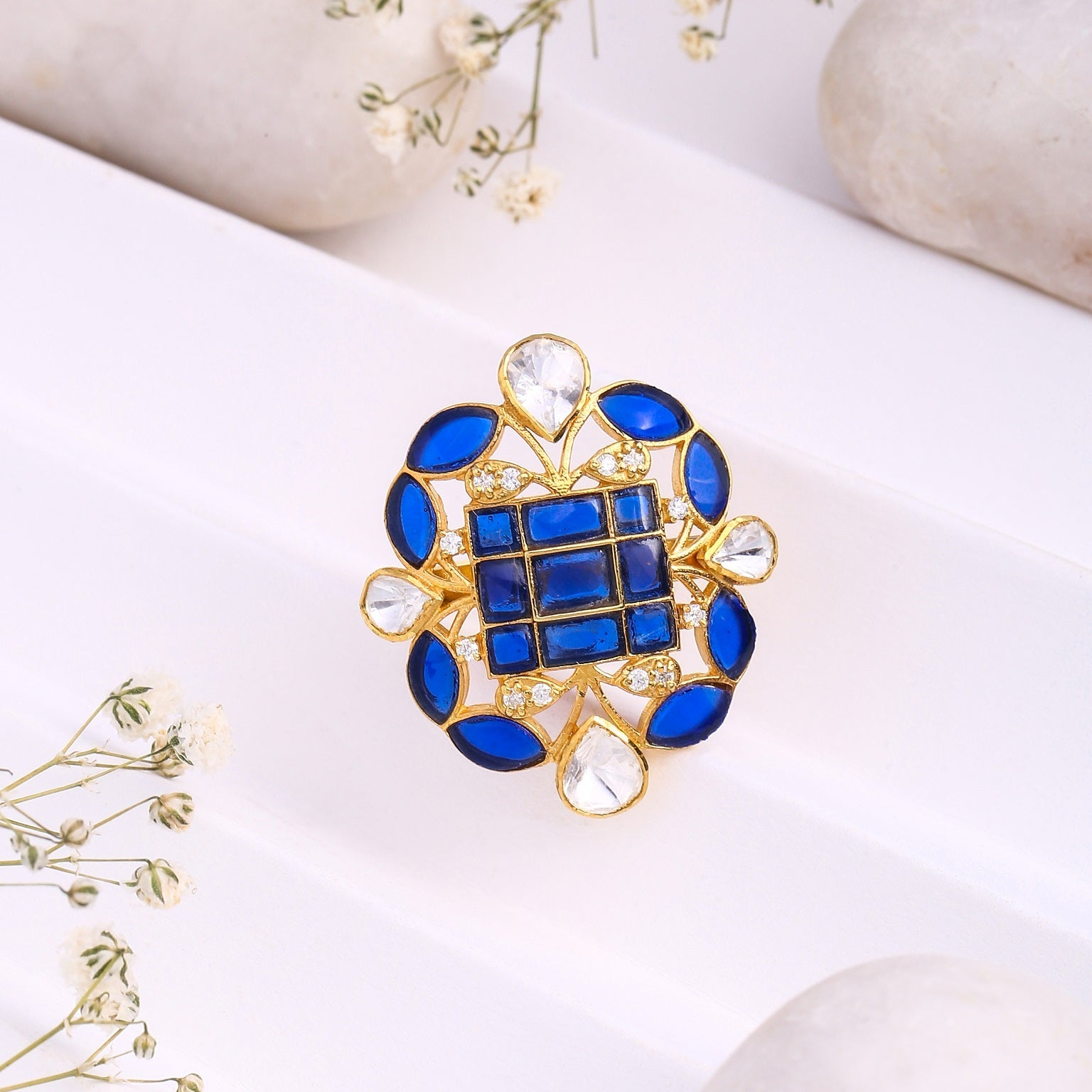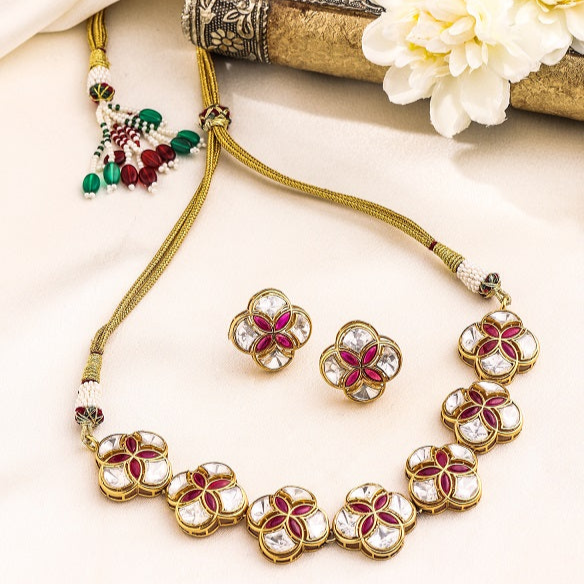Artikel: Entwicklung: Eine kurze Geschichte des Kundan-Schmucks
Entwicklung: Eine kurze Geschichte des Kundan-Schmucks
Eine Art von Goldschmuck, der als Kundan bekannt ist, hat typischerweise einen Wachskern. Da sich das Wort „Kundan“ selbst auf hochraffiniertes reines Gold bezieht, wird für diese Art von Schmuck typischerweise 24 Karat reines Gold verwendet. Mit einer langen Geschichte, die mehr als 2.500 Jahre zurückreicht, ist Kundan-Schmuck eine der ältesten Schmuckarten in Indien. Nur der Jadayi-Teil, der letztendlich als Kundan bezeichnet wird, besteht aus 24 Karat Gold, da der Rest des Schmucks nicht daraus hergestellt werden kann, da es etwas weicher ist. Jadau-Schmuck ist ein anderer Name für das Handwerk der Kundan-Herstellung.
GESCHICHTE DES KUNDAN-SCHMUCKS
Kundan-Schmuck ist eine der ältesten Schmuckarten Indiens und hat seinen Ursprung in der Rajput- und Mogul-Epoche. Die Unterstützung der Moguln ermöglichte diesem Stil, zu blühen, nachdem er vor vielen Jahren in der Nation eingeführt wurde. Königliche Familien in Indien haben ihn danach erfolgreich übernommen. Die Kunst und Handwerkskunst der Mogul- und Rajput-Epoche sind noch heute in dieser Art von Schmuck zu sehen.
Herstellungsverfahren für Kundan-Schmuck
Die Herstellung von Ghats aus 22-karätigem Gold, oft als Gadhayi bezeichnet – einzelne Stücke aus Goldstreifen – ist der erste Schritt bei der Herstellung von Kundan -Schmuck. Dünne Goldstreifen, die gehackt, aufgerollt und in die Form eines gemeinsamen, gussähnlichen Rahmens gebracht werden, werden verwendet, um das Bild zu erzeugen. Dies ist der wichtigste Schritt, um die Grundlage für das Stück zu legen. Im zweiten Prozess, Khudayi genannt, werden die erforderlichen Muster und Designs in die Außenfläche eingraviert. Bei diesem Verfahren wird der Rahmen mit Gold oder Lack (einer Art Wachs) gefüllt, das dann geätzt wird. Bei dieser Technik wird im Wesentlichen das gewünschte Muster oder Design in die Oberfläche des Schmuckstücks geätzt.
Die geschnitzten Muster auf der Goldoberfläche werden dann in einem Meenakari genannten Prozess mit verschiedenen natürlichen Farben gefüllt. Schließlich wird Jadayi durchgeführt, um teure, seltene Steine wie Diamanten, Polkis, Smaragde, Saphire und Rubine in das Schmuckstück einzuarbeiten und so dessen Schönheit hervorzuheben. Bei dieser Methode wird der Edelstein eingesetzt, indem eine Goldfolie zwischen die Steine und ihre Fassung gelegt wird. Dann werden sie, um genügend Halt zu haben, auf der Oberfläche des Schmuckstücks platziert und durch die Goldfolie gestützt.
WIE LANGE DAUERT ES, EIN KUNDAN-SCHMUCKSTÜCK HERZUSTELLEN?
Die filigrane Beschaffenheit der Kundan- Schmuckstücke erfordert viel spezialisierte Arbeit. Jedes Stück wird von Hand gefertigt und erfordert viele Arbeitsstunden talentierter Handwerker. Je nach Fachwissen und Komplexität des gewünschten Designs kann die Herstellung eines schlichten Kundan- Schmuckstücks zwei bis vier Monate dauern.
In Kundan-Schmuck verwendete Motive
Es gibt keine festgelegten Standards für die Verwendung bestimmter Motive in Kundan -Schmuck. Die typischsten Inspirationsquellen sind jedoch Natur und Architektur. Die Themen werden aus verschiedenen Elementen davon aufgebaut, wobei Blumen immer wieder ein beliebtes Motiv sind. Normalerweise verewigen die Motive der Stücke die schönen Formen von Tulpen, Lotusblumen und Nelken.
Entwicklung der Kundan-Kunst
Kundan-Schmuck zeichnete sich historisch durch äußerst kunstvolle und exquisite Motive aus. Früher wurde er nur für Königsfamilien hergestellt. Dieses Schmuckdesign hat sich im Laufe der Zeit verändert und wurde sogar in Silbermetall nachgeahmt. Als die Kommerzialisierung Einzug hielt, konnte auch der Durchschnittsbürger diese Art von Schmuck kaufen. Das Niveau der Handwerkskunst hat im Gegensatz zu früheren Zeiten abgenommen, da die Zugänglichkeit erweitert wurde. Nur ausgewählte Handwerker können sich heute darauf verlassen, dass sie echte, qualitativ hochwertige Arbeit leisten. Ein Gegenstand, dessen Herstellung früher drei bis vier Monate dauerte, sollte idealerweise in einem Monat hergestellt werden.
ECHTER - GEFÄLSCHTER KUNDAN-AUSWEIS
Beim Einkaufen ist es wichtig, sich gut mit echtem Kundan-Schmuck auszukennen. Um zwischen gefälschten und echten Stücken zu unterscheiden, muss man sich grundlegend mit Schmuck und Handwerk auskennen. Kundan-Schmuck sollte jedoch mit Qualitätszertifikaten des Juweliers versehen sein, da er in 24-karätiges Gold eingefasst ist. Um die Möglichkeit gefälschter Schmuckstücke zu verringern, können Sie auch nach Echtheitsstempeln auf dem Schmuck suchen.
KULTURELLE BEDEUTUNG VON KUNDAN-SCHMUCK FÜR BRÄUTE
Kundan wird wegen seines raffinierten und anmutigen Aussehens häufig bei Hochzeiten getragen. Traditioneller indischer Schmuck war schon immer recht sperrig und bestand aus großen Goldstücken. Kundan-Schmuck wird derzeit mit der Zeit leichter und indische Bräute greifen wieder zu ihm. Jede Braut möchte an ihrem Hochzeitstag strahlen und Königliche bevorzugen diesen Schmuckstil aus gutem Grund. Schwere Diamantbesätze passen häufig nicht zum traditionellen Brautoutfit oder Kundan-Schmuck.
A type of gold jewellery known as Kundan typically has a wax core. Since the word "Kundan" itself refers to highly refined pure gold, this kind of jewellery typically uses 24k pure gold. With a long history dating back more than 2,500 years, Kundan jewellery is one of the oldest types of jewellery in India. Only the Jadau portion, which is finally referred to as Kundan, is done in 24 karat gold because the rest of the jewellery cannot be manufactured from it because it is a little softer. Jadau jewellery is another name for the craft of creating Kundan.
HISTORY OF KUNDAN JEWELLERY
Kundan jewellery is one of the earliest types of jewellery made in India, with origins in the Rajput and Mughal eras. The Mughals' support allowed this style to flourish after it was introduced to the nation many years ago. Royal families in India successfully adapted it after then. The art and craftsmanship from the Mughal and Rajput eras may still be seen in this type of jewellery today.
Minimalist jewellery doesn't necessarily mean plain or boring. The Pietra Collection embraces minimalist aesthetics but infuses them with playful elements through the use of colourful gemstones. The simplicity of the designs ensures that the focus remains on the stone, allowing its natural beauty to shine. This balance between minimalism and colour creates a look that is both chic and expressive. For customers, understanding this blend is essential. Minimalist designs allow for versatility, meaning you can wear Pietra pieces both on casual outings and formal events. The collection offers a wide range of options from delicate pendants to bold bracelets, all featuring the signature colourful stones.
CRAFTING PROCEDURE OF KUNDAN JEWELLERY
Making ghat in 22 karat gold, often referred to as gadhayi—individual pieces built with golden strips—is the first step in the creation of Kundan jewellery. Thin golden strips that are chopped, coiled, and moulded into the shape of a common mould-like framework are used to create the image. The most crucial action to lay the piece's groundwork is this one. In the second process, called khudayi, the exterior surface is engraved with the necessary patterns and designs. This procedure involves filling the framework with gold or lac (a form of wax), which is then etched. This technique essentially entails etching the intended pattern or design onto the jewellery item's surface.
The carved designs on the gold surface are then filled with various natural colours in a process called Meenakari. Finally, jadayi is performed to put expensive, rare stones like diamonds, polkis, emeralds, sapphires, and rubies in the piece of jewellery in order to accentuate its beauty. In this method, the gem is set by sandwiching a gold foil between the stones and their mounting. Then, for enough grip, they are positioned on the jewellery item's surface and supported by the gold foiling.
HOW LONG DOES IT TAKE TO CRAFT ONE PIECE OF KUNDAN JEWELLERY?
The delicate nature of Kundan pieces necessitates a lot of specialised labour. Each piece is hand-finished, requiring many hours of labour from talented craftspeople. Depending on the level of expertise and the complexity of the desired design, it may take two to four months to create a modest piece of Kundan jewellery.

MOTIFS USED IN KUNDAN JEWELLERY
There are no set standards for using particular motifs in Kundan jewellery. Nature and architecture are the most typical sources of inspiration, nevertheless. The themes are built using various elements of these, with florals being a favoured motif again and time again. Usually, the motifs of the pieces immortalise the lovely forms of tulips, lotuses, and carnations.
EVOLUTION OF THE ART OF KUNDAN
Kundan jewellery has historically featured extremely elaborate and exquisite motifs. It used to be made only for royal families. This jewellery design has changed over time and has even been imitated in silver metal, expanding to silver wedding jewellery markets. When commercialisation gained hold, the average person could also purchase this type of jewellery. The level of craftsmanship has decreased in contrast to earlier times as accessibility has expanded. Only chosen craftspeople may now be relied upon to provide genuine, high-quality work. An item that used to take three to four months to create should ideally be produced in one month.

REAL - FAKE KUNDAN IDENTIFICATION
Having a thorough knowledge of authentic Kundan jewellery is crucial when shopping. To distinguish between fake and authentic pieces, one must fundamentally understand jewellery and craftsmanship. Kundan jewellery should, however, come with quality certifications from the jeweller since it is set in 24-carat gold. To reduce the possibility of fake jewellery, you may also look for genuine stamps on the jewellery.
CULTURAL SIGNIFICANCE OF KUNDAN JEWELLERY FOR BRIDES
Kundan is frequently used at weddings because of its refined and graceful appearance. Indian traditional jewellery has always been quite bulky and made up of large gold pieces. Kundan silver jewellery is currently being made lighter in weight with time, and Indian brides are once again embracing it, often paired with silver wedding jewellery to achieve a balanced look. Every bride wants to shine on her wedding day, and royals prefer this jewellery style for a reason. Heavy diamond sets frequently do not match the traditional bridal outfit or Kundan jewellery.
CULTURAL SIGNIFICANCE OF KUNDAN JEWELLERY FOR BRIDES
Kundan is frequently used at weddings because of its refined and graceful appearance. Indian traditional jewellery has always been quite bulky and made up of large gold pieces. Kundan silver jewellery is currently being made lighter in weight with time, and Indian brides are once again embracing it, often paired with silver wedding jewellery to achieve a balanced look. Every bride wants to shine on her wedding day, and royals prefer this jewellery style for a reason. Heavy diamond sets frequently do not match the traditional bridal outfit or Kundan jewellery.
Wedding Kundan Collection

















